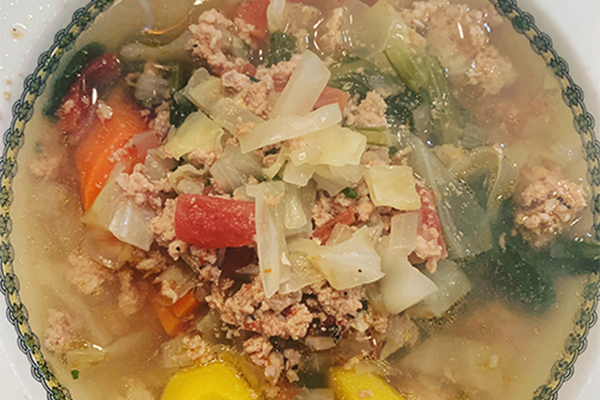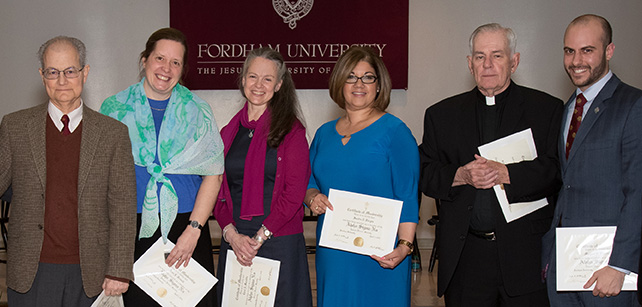“There’s something really important about the fact that we are in the business of teaching,” said Tetlow. “If there’s anyone who should understand how to spread information, how to help people understand—it’s us. So how do we model our own pedagogy with each other?”
Tetlow spoke on the Twice Over Podcast, which was developed during the beginning of the COVID-19 pandemic as a way to find meaning and connection during a turbulent time. Over the past two years, it evolved into a platform where students, faculty, administrators, and guest speakers at other academic institutions share effective practices in their work and build connections through candid conversations. More than 40 guests have been interviewed by the podcast’s two hosts: Steven D’Agustino, director of online learning, and Anne Fernald, special advisor to the provost. They conduct recording sessions in a sound-controlled studio within the Learning, Innovation, Technology Environment, a new center in the basement of Walsh Library where students, faculty, and administrators use cutting-edge technology for their research.
The podcast episode featuring Tetlow was published on Nov. 28. For nearly an hour, Tetlow speaks in depth on many topics, including why she decided to work in higher education and how her second grade teacher changed her life. The podcast episode can be streamed on Twice Over’s website, Apple Podcasts, Spotify, Stitcher, SoundCloud, and YouTube.
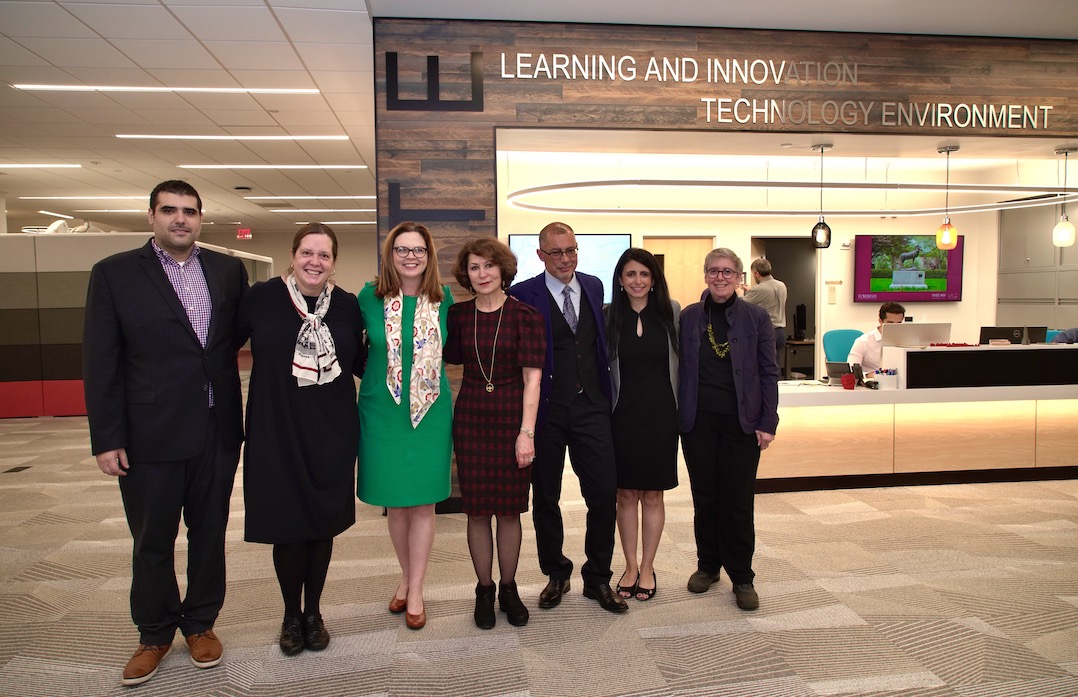
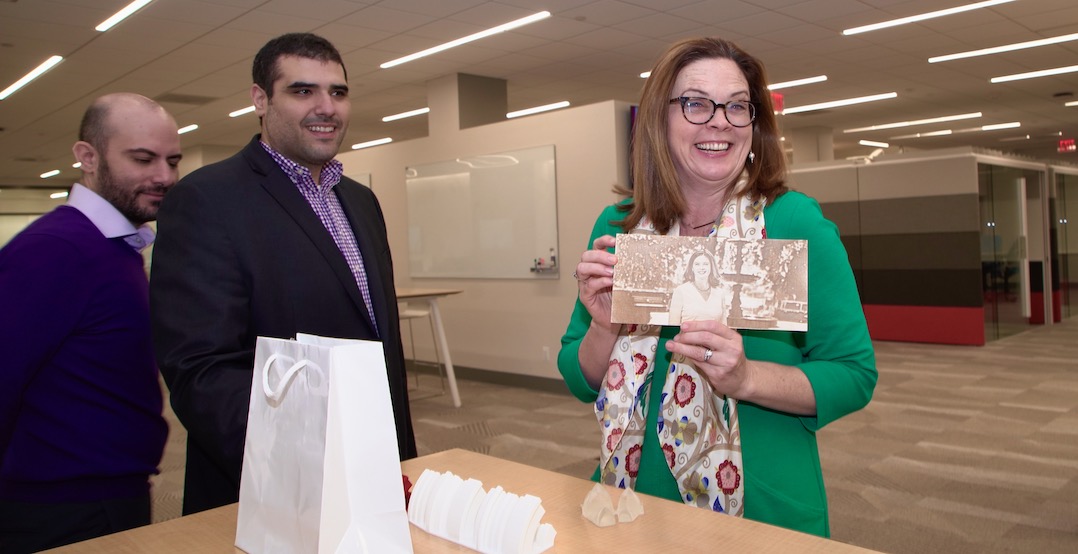
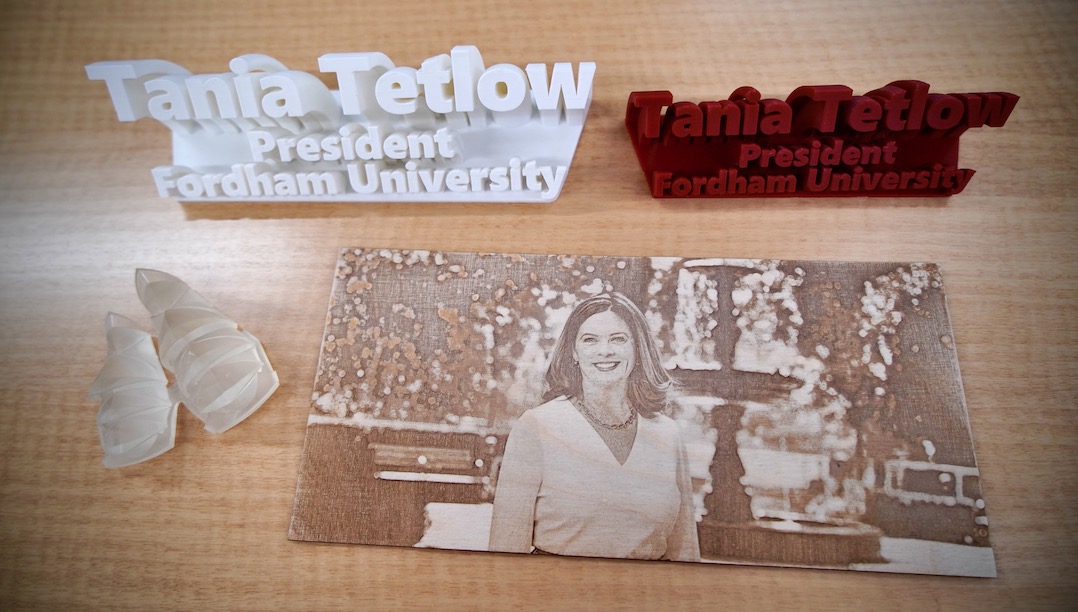
If you’re worried you’ve exhausted all your Netflix options, look no further. Fordham News asked faculty and staff members for updated suggestions on the best things to read, watch, and listen to for the upcoming winter months. (In case you missed it, check out our last list of faculty recommendations here.)
Films
Jennifer Moorman, Assistant Professor in the Department of Communication & Media Studies
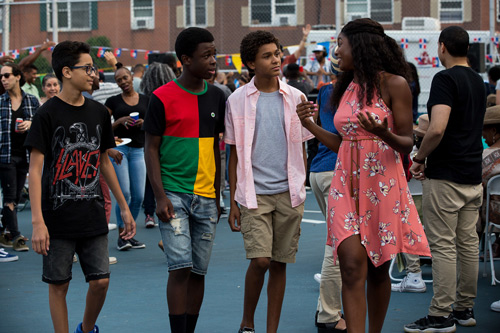
Vampires vs. The Bronx (2020), directed by Osmany Rodriguez
I know Halloween is over, but it’s always horror season for me! This one was actually recommended to me by a student in my Horror Film class, and I found it moving as well as fun. A horror-comedy focused on three boys battling vampires while simultaneously fighting off gentrification in their Bronx neighborhood (an issue that should concern all of us at Fordham), this film has so much heart. It has its share of cheesy moments and clichés, but overall it entertains while reminding us that Black lives matter, our communities are worth saving, and we are stronger together.
Available on Netflix
Bacurau (2019), directed by Kleber Mendonça Filho & Juliano Dornelles
This Brazilian riff on The Most Dangerous Game is a thrilling, powerful, anticolonial tour de force. Warning: It gets pretty graphic. But its messages about the dangers of globalization, imperialism, and white supremacy are as urgent as ever, and will hopefully inspire you to organize in your own community to fight the power. Its meditation on the ways that advanced technologies invade our lives and can hurt as much as they help is particularly relevant in this moment of ever-increasing dependency on digital (and specifically remote-learning) tech.
Available on Amazon
Portrait of a Lady on Fire (2019), directed by Céline Sciamma
Arguably the greatest queer love story (or any love story, for that matter) of the 21st century thus far. Exquisitely shot, each frame is a painting. The compositions are breathtaking, the characters written and portrayed with unusual depth, and the story is incredibly moving and all too relatable for anyone who has a “one that got away.”
Available on Hulu
The Lighthouse (2019), directed by Robert Eggers
This is a great companion piece to Robert Eggers’ previous feature, The Witch (which I also highly recommend). It’s darker and more challenging, but also funnier. Its exploration of the horrors of isolation feels all the more relevant now than at the time of its release, and if you look beneath the surface, you’ll find a biting critique of capitalism and toxic masculinity (and some would say, also a homoerotic love story).
Available on Amazon
Beth Knobel, Associate Professor in the Department of Communication and Media Studies
Broadcast News (1987), directed by James L. Brooks
This is one of my favorite films about television news. It’s also filled with classic moments that speak to the nature of friendship, success, and love. I’ve shown it numerous times to my Fordham students to illustrate the power and limitations of broadcast journalism.
Available on Amazon
Eyes on the Prize: America’s Civil Rights Years 1954-1965 (1987)
Eyes on the Prize II: America at the Racial Crossroads 1965-1985 (1990)
Produced by Henry Hampton
Everyone who wants to understand the roots of the American civil rights movement should spend the time to watch Henry Hampton’s monumental, prize-winning documentary series Eyes on the Prize. Its 14 parts, produced as two series, explore the major moments of the movement, from school desegregation, to the fight for voting rights, to the elections of Black politicians in major cities like Chicago. It’s engrossing and important.
Available on Amazon
Brandy Monk-Payton, Assistant Professor in the Department of Communication and Media Studies
Time (2020), directed by Garrett Bradley
This award-winning experimental documentary by Garrett Bradley is a beautiful and intimate portrait of a Black family that follows Sybil “Fox Rich” Richardson as she fights for over 20 years to free her husband from his prison sentence. Using interviews as well as Rich’s own homemade videos, the film is a brilliant love story in an era of mass incarceration.
Available on Amazon
Television Shows
Brandy Monk-Payton
The Queen’s Gambit (2020)
Based on a 1983 novel of the same name, this limited series is a coming-of-age story about Beth Harmon, an orphan who also happens to be a chess prodigy. Set during the Cold War, Beth defies the odds as a female player who gains widespread public attention winning in a male-dominated sport, while also privately battling addiction. Watch for the mesmerizing scenes of chess play.
Available on Netflix
Grand Army (2020)
This gritty young adult drama series is set in Brooklyn and follows a multicultural ensemble of teenagers as they confront issues of identity at their prestigious public high school. At times difficult to watch due to its themes, the film has vivid characters and stellar performances by the young cast.
Available on Netflix
Jacqueline Reich, Professor in the Department of Communication and Media Studies
My Brilliant Friend (2018-present)
There are two seasons available of this amazing adaptation of Elena Ferrante’s four novel series set in Naples beginning in 1945. Most of the actors are non-professional, and there are wonderful echoes to Italian neorealism and other film traditions. It is compelling storytelling at its best, and when we can’t travel to Italy, the series transports us there.
Available on HBO
Borgen (2010-2013)
Borgen is probably one of the most highly praised international television series in recent memory, and Netflix subscribers can now see it for the first time. It revolves around the first Danish female prime minister and her family as she adapts to her new role. You will be riveted. Also along these lines on Netflix is The Crown, with Season 4 having just been released.
Available on Netflix

The Mary Tyler Moore Show (1970-1977)
One of the pioneering television series of the 1970s, Mary Tyler Moore plays Mary Richards, a single career woman living in Minneapolis. It was one of the first shows to feature work life and home life (modeled after The Dick Van Dyke Show, also starring Moore), and spawned several spinoffs (Rhoda, Phyllis, Lou Grant). I watched all seven seasons during the worst of the quarantine, and Mary’s sunny disposition and optimism were just what I needed. For a great companion read, I recommend the book Mary and Lou and Rhoda and Ted by Jennifer Kieshin Armstrong, which tells the background story behind the scenes.
Available on Hulu
Clint Ramos, Assistant Professor of Design and Head of Design and Production

Alone (2015-present)I love it because it shows you how we really need socialization.
Available on Netflix
Street Food (2019)
It’s set both in Asia and Latin America. I love it because it’s not about the food, it’s about the people who make the food.
Available on Netflix: Asia and Latin America
Beth Knobel
Occupied (2015-2017)
This multilingual Norwegian three-season television series revolves around a Russian invasion of Norway over energy resources. As someone who spent 14 years living in Moscow, working as a journalist, I was glued to the edge of my seat by the portrayal of the Russians and the twists and turns in this biting political thriller.
Available on Netflix
Books
Heather Dubrow, Professor of English; John D. Boyd, S.J. Chair in the Poetic Imagination; and Director, Reading Series, Poets Out Loud
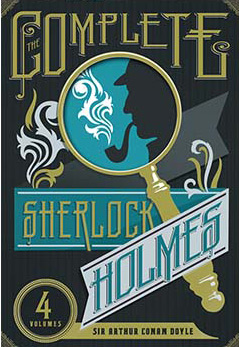 Detective fiction and crime fiction in general! Long-standing favorites include Sherlock Holmes and Ed McBain, especially the ones about the 87th precinct, which I enjoy not least because they are set in New York.
Detective fiction and crime fiction in general! Long-standing favorites include Sherlock Holmes and Ed McBain, especially the ones about the 87th precinct, which I enjoy not least because they are set in New York.
Michael Connelly has been another favorite for some years—partly because of how the values of the detective are represented (he repeatedly evokes police work as a “mission”) and also because of how the relationship with his daughter has developed in the course of the series. But OK, I’ll let the cat out of the bag: I’m writing a critical article on Connelly, which demonstrates that I need to try harder to follow the advice I give my students about getting away completely from academic work occasionally.
The Remains of the Day by Kazuo Ishiguro
What an extraordinary eye and ear he has for English culture.
Seamus Heaney
Not surprisingly, I keep returning to Heaney, virtually any of his poetry books and prose too.
Why I Am Not a Toddler by Cooper Bennett Burt
Given our troubled times I’d recommend for light reading, especially to people who enjoy some of the originals, the parodies of golden oldie poems Stephanie Burt claims were written by her infant son. One of my favorites there is in fact a riff on the Bishop poem that is itself one of my favorites, “One Art.” [Bishop’s compelling lament, “The art of losing isn’t hard to master” becomes the kid’s “The art of mouthing isn’t hard to master . . . And look! my last, or / next to last, of three big crayons…”]
Art Deco Chicago: Designing Modern America by Robert Bruegmann (Editor)
I love reopening and flipping through art books, including catalogues of exhibits to which I’ve gone. Art deco means a lot to me, and right now that bedside table also includes a book on deco mailboxes, a sub-sub genre of art deco design no doubt. And I often revisit a couple of books I have on the lacquer creations and other work of Zeshin—wow.
Music
Chuck Singleton, General Manager, WFUV
WFUV’s The Joni Project, which features artists covering songs by iconic singer-songwriter Joni Mitchell
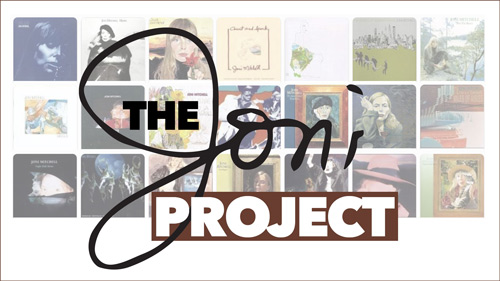
Our Stress-Free Soundtrack pandemic playlist
The EQFM “Album ReCue” series, on landmark albums from women, which includes Spotify playlists of every album and Alisa Ali’s conversation with WFUV DJs
George Bodarky, News Director, WFUV
Everyone should have Nina Simone’s “O-o-h Child” on their playlist, especially now.
But really tapping into ’70s R&B has been uplifting, including “Shining Star” from Earth, Wind & Fire.
Anne Fernald, Professor of English and Women’s, Gender, and Sexuality Studies
Every summer, my family and I make a summer playlist. The rule is that it has to be brief enough to fit on a CD (so 100 minutes or so) and that it should capture the mood of the summer. We spend our summers up on the New York side of the Canadian border, listening to a lot of CBC 2. Their smooth-voiced nighttime DJ is a musician called Odario Williams, and his “Low Light (In This Space)” is a song that captures the hopes and aspirations coming out of #BlackLivesMatter.

Also on that playlist was Phoebe Bridgers’ “Kyoto,” which is both heart-breaking and inspiring and just grows and grows on me.
And I am always charmed by the Swedish song “Snooza” by Säkert! It’s (apparently) about urging your lover to hang out and snooze a little longer. It’s a very cheerful pop song in a language I don’t speak and one of those gifts from the algorithm: a “you might like” song that I love.
]]>Anne Fernald’s “Whatever” Soup
Anne Fernald, Ph.D., professor of English and women’s, gender, and sexuality studies, has maintained her Sunday night efforts to cook for the work week. “I realized that if I did not do it, I would revert to my natural diet, which is bread and cheese with some butter,” she says. “I do nothing but teach and cook these days and, in a welcome development, my husband has been cooking a tiny bit, too.” Her favorite recipe hails from The New York Times’ Samin Nosrat. It’s called Whatever You Want Soup, and it “serves as a canvas for any kind of chunky soup,” Nosrat writes. Here is Fernald’s take on it.
Ingredients
4 tablespoons butter, olive oil, or neutral-tasting oil
2 medium onions, diced
3 cloves garlic, sliced
Kosher salt
6 to 8 cups meat, vegetables, or other add-ins
Ground turkey
Shredded cabbage
Carrots, cut into rounds
Tomato, chopped
Green onion, sliced
1 1⁄2pounds raw, boneless chicken (optional)
8 cups water or chicken stock, preferably homemade
Steps
1. Set a large Dutch oven or stockpot over medium-high heat and add 4 tablespoons butter or oil. When the butter melts or the oil shimmers, add onions and garlic, and a generous pinch of salt.
2. Reduce the heat to medium and cook, stirring occasionally, until the onions are tender, about 15 minutes.
3. Place the meat, vegetables, and other add-ins in the pot, along with the raw chicken (if using), and add enough liquid to cover. Season with salt. Increase heat to high and bring to a boil, then reduce to a simmer.
4. Cook until the flavors have come together and the vegetables and greens are tender, about 20 minutes more. If you added raw chicken, remove it from the soup when cooked, allow to cool, shred, and return to the soup. Taste and adjust for salt.
5. Add more hot liquid if needed to thin the soup to desired consistency. Taste and adjust for salt.
6. Serve hot, and garnish as desired.
Yield: 6 to 8 servings l Time: About 45 minutes
Base recipe courtesy of Samin Nosrat/The New York Times
The Raffetto Family’s Pink Rice

Raffetto’s has been selling made-in-house pasta and other Italian specialties on New York City’s Houston Street since 1906, spanning four generations of the family. The two most recent generations include brothers Richard, FCRH ’82, and Andrew, FCRH ’84, and Andrew’s daughter Sarah, PCS ’13. Romana Raffetto, Richard and Andrew’s mother, made this dish many times over the years. The Raffettos still make it regularly, Sarah says, because it is so delicious, comforting, and easy. “We use the Reggiano crumbs because, like Nonna taught us, we try not to waste anything, and while cutting wheels of cheese for retail we save the broken crumbs for future recipes.”
Ingredients
1 cup Arborio rice
1 ice cream scoop of salt (a common measurement in our kitchen)
4 tablespoons (1⁄2 stick) butter
4 tablespoons Raffetto’s tomato and basil sauce (or a similar sauce of your choice)
Parmigiano-Reggiano crumbs to taste
Steps
1. Bring a pot of salted water to boil. Add rice, cover, and cook for 20 minutes.
2. While the rice is cooking, you can get the butter ready by melting it in a bowl. Otherwise, make sure that the butter is out long enough to soften so it will melt easily when the rice is done cooking.
3. When the rice is cooked, strain with a fine mesh strainer and add to the bowl with butter. Stir in Raffetto’s tomato and basil sauce (or any red sauce) in tablespoon increments, adding more or less as desired.
4. Stir in Parmigiano and eat immediately while everything is warm and the cheese melts, resulting in a beautiful light pink color with chunks of tomatoes.
Note: “Nonna Romana hardly ever measured anything,” Sarah says. “She was a casual cook who
knew by eye more than numbers. Modify slightly to your needs and enjoy!”
Yield: 4 to 6 servings l Time: About 20 minutes
Taylor Ha’s Whipped Coffee

Fordham graduate student and Fordham News staff writer Taylor Ha recently recorded herself making a drink that’s gone viral amid the pandemic. Whipped coffee, a four- ingredient beverage that originated in South Korea, was recently featured on TikTok’s trending page, with more than 312,000 videos using the hashtag #whippedcoffee, according to ABC News. In their home kitchen, Ha and her mother created their own version of the popular drink, complete with a slow-motion video of the production process. They also made spaghetti aglio e olio. “Both were delicious and super satisfying to make,” Ha says. “I’ll admit I didn’t actually cook, since I was filming everything, but it was nice to bond with my mom at home.”
Ingredients
2 tablespoons sugar
2 tablespoons instant ground coffee
2 tablespoons freshly boiled water
1 cup almond milk or any other milk (enough to fill a glass 3⁄4 of the way up)
Steps
1. Combine the sugar, instant coffee, and boiled water in a small bowl, whisking the mixture until it becomes silky smooth and turns a light shade of brown. Set aside.
2. Place a few ice cubes in a glass cup and fill the cup three-quarters full with almond milk.
3. Add a few dollops of whipped coffee on top and gently stir the whole thing.
Daejah Woolery’s Jamaican Dumplings with Jerk Chicken and Butternut Squash
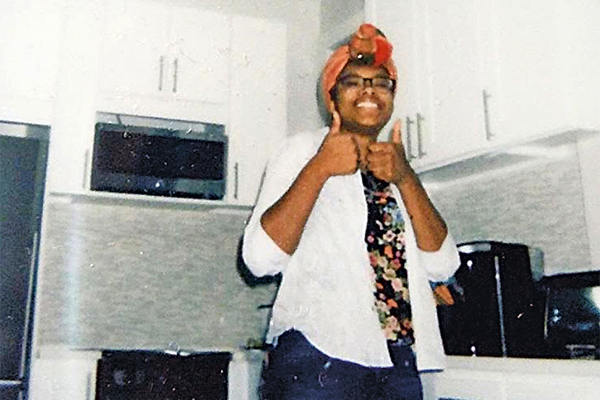
When Fordham College at Lincoln Center sophomore Daejah Woolery moved off campus, she started cooking more. She says she doesn’t always have the time to make elaborate dishes, but as a Jamaican, “food is super important to the culture,” so she makes an extra effort to cook from scratch. “I’m excited to make this for my family and show them my slight twist on Jamaican boiled dumplings with chicken!”
Ingredients
Boiled dumplings
2 cups flour
5 teaspoons salt
1⁄4 cup cornmeal
1⁄2 cup cold water
Jerk seasoning (Note: bottled jerk seasoning can be substituted.)
1 tablespoon garlic powder
2 to 3 teaspoons cayenne pepper
2 teaspoons onion powder
2 teaspoons salt
1 teaspoon paprika
1 teaspoon ground allspice
1⁄2 teaspoon black pepper
1⁄2 teaspoon dried crushed red pepper
1⁄2 teaspoon ground nutmeg
1⁄4 teaspoon cinnamon
Butternut squash, as much as you like, cut into cubes
Chicken, any cut, as much as you like, cut into cubes
(Note: I typically use 2 boneless chicken breasts and 12 oz. frozen, pureed butternut squash.)
Steps
1. Bring a large pot of water to a boil.
2. Combine flour, salt, cornmeal, and cold water. Adjust until you have a dough that doesn’t stick to your hands.
3. Make small disc-like shapes and drop them into the boiling water for about 10 minutes. Try not to overcrowd your pot! Remove from heat and set aside. Or they can remain in the water with the heat off.
4. Combine all jerk seasoning ingredients and set aside.
5. Bring another large pot of water to a boil and add squash cubes.
6. When squash is softened, after about 15-20 minutes, puree or mash it finely.
7. Heat pureed squash in a saucepan on medium-low heat and add some of your jerk seasoning to taste. Switch to low heat after you see bubbles. Add about 1⁄4 cup of water if you want a thinner sauce.
8. Season the chicken with jerk seasoning and cook it however you like; throw it in the air fryer if you’re in a rush or sauté it like I usually do.
9. Once the chicken is cooked, add it to the saucepan with the squash and resist the urge to eat it immediately. Let it simmer together on medium-low heat for 5 minutes. Make sure the chicken gets surrounded by the sauce. The sweet and nutty taste of the squash will interact really well with the jerk seasoning.
10. Transfer the dumplings to a plate and put some chicken and squash directly on top!
Yield: 4 servings l Time: About 60 minutes
Clint Ramos’ Filipino Chicken Adobo

Clint Ramos, head of design and production in the Fordham Theatre program, has won several awards, including a Tony and an Obie, for his set and costume designs. He posted a photo of his chicken adobo on Instagram that prompted inquiries about the recipe. With roots in the activist street theater scene in Manila, he advises that one eat the dish while pondering “how much of what you enjoyed was indigenous or a result of Spanish colonialism.”
Ingredients
2 pounds boneless chicken thighs (I like skin but you can also do skinless)
4 dried bay leaves
8 tablespoons dark soy sauce (I use Kikkoman)
8 tablespoons coconut vinegar (apple cider vinegar will also do well)
8 cloves garlic, peeled and crushed
11⁄2 cups water
3 tablespoons cooking (canola or any high heat) oil
1⁄4 teaspoon salt (optional—the salinity from the soy may be enough)
1 teaspoon whole peppercorns
1 teaspoon brown sugar
Steps
1. Marinate chicken in soy sauce, vinegar, and garlic for at least 3 hours or overnight in the fridge.
2. Separate chicken from marinade, removing as much of the liquid as possible. Save all of the marinade (this will be your braising liquid).
3. Heat oil in a pan on medium-high heat and brown chicken on both sides (about 2 minutes per side).
4. In the same pan, pour in the marinade (garlic and all) and water. Bring to a boil.
5. Add bay leaves and peppercorns and reduce heat to low to simmer.
6. Simmer for 30 minutes or until chicken is tender. I completely cover it for 15 minutes and let some of the steam out for the remaining 15 with a wooden spoon lodged between lid and pot. Important: Watch that the liquid reduces to a slightly thickened sauce but not completely.
7. Add sugar and cook for another 5 to 10 minutes.
8. Serve over hot white or brown rice and enjoy!
Yield: 6 to 8 servings l Time: About 60 minutes
Loren Avellino’s Banana Lace Cookies

As a first-generation Italian-American woman, Loren Avellino, FCLC ’07, says she practically grew up in the kitchen. In fact, when she got the opportunity to live in McMahon Hall for the summer as an orientation coordinator at the Lincoln Center campus, she hosted pasta nights for fellow summer residents. Today, she has a degree in culinary arts, a catering company, and a food blog. She recently started a video cooking series on her Instagram page, @lo_go_cook. “When I’m in the kitchen, my anxiety seems to melt away, and if I can take others on that journey with me, especially during these uncertain times, then I’ve done a tiny part to help during this crisis,” Avellino says.
Ingredients
1⁄2 cup (1 stick) unsalted butter, softened
1 cup white sugar
1 teaspoon white or apple cider vinegar
1 cup mashed brown bananas (about 2 large bananas)
1 teaspoon baking soda
1 cup all-purpose flour
1 cup almond flour*
1 teaspoon salt
1 teaspoon vanilla extract
1 cup dark chocolate chips
*Almond flour is important for crispy, lacy cookies (see tip on next page about using only all-purpose flour)
Steps
1. Preheat the oven to 350°F. Beat together the butter and sugar until fluffy.
2. Add the vinegar and vanilla and continue to beat until incorporated. The vinegar helps to offset the sweetness of the ripe bananas.
3. Add the baking soda in with the mashed bananas, then mix into the butter mixture.
4. Whisk together the all-purpose flour, almond flour, and salt. Add to the batter and mix until just combined.
5. Fold the dark chocolate chips into the batter.
6. Drop tablespoon-size amounts of batter onto parchment or silicone-lined baking sheet, making sure they are about 2 inches apart. You should have 42 to 48 cookies.
7. Bake 12 to 14 minutes until the edges are dark brown. (The dark color is important for crispy cookies). Let the cookies cool on the cookie sheet for at least 10 minutes before moving to a wire rack to complete cooling.
Tip: You could use only all-purpose flour, but the cookies will be denser and less crispy than the almond flour version.
Yield: 42 to 48 cookies l Time: About 45 minutes
B.A. Van Sise’s Ricotta Gnocchi with Roasted Pepper Sauce

Photojournalist B.A. Van Sise, FCLC ’05, jokes that his mother preferred food “so heavy that a black hole would not easily escape its pull.” For her homemade gnocchi, she’d replace the potato with rich, creamy ricotta and make the supple dough herself, rolling it and cutting it by hand. “It’s an easy activity that does not need but asks for six hands,” Van Sise says. “Recruit your kids for help, if you’ve got them. Trust me: they’ll remember it, fondly.”
Ingredients
Pasta
2 pounds ricotta cheese
4 eggs
4 cups flour
2 teaspoons salt
1 teaspoon pepper
Sauce
1 16 oz. jar roasted red peppers
1⁄2 cup heavy cream
4 tablespoons garlic
2 tablespoons butter
1⁄2 teaspoon dried basil
black pepper
Steps
1. In a large mixing bowl, mix the ricotta and eggs. Gradually add the flour, salt, and pepper.
2. Knead well on a floured board and roll into finger-sized long rolls, then cut into pieces about 3⁄4 inch long.
3. Bring a large pot of salted water to a boil. Add the gnocchi, stirring gently from time to time to make sure they don’t mingle too much. Cook for 8 minutes.
4. Meanwhile, in a blender, add the roasted red peppers as well as about 2 tablespoons of liquid from the jar, and puree.
5. In a saucepan, sauté the garlic and butter for approximately 2 minutes until both the butter and garlic soften; add the pureed peppers, the basil, and a little bit of black pepper. Simmer for 5 minutes, then add the heavy cream and simmer for 5 more.
6. Cover the drained gnocchi with the sauce, and either serve right away or put into a preheated oven at 350 degrees for 10 minutes to crisp them up.
Yield: 4 to 6 servings l Time: About 40 minutes
Serving Those Who Are Hungry
The economic impact of the coronavirus pandemic has led to an increase in the number of people who can’t afford food and are at risk of going hungry. Fordham graduates are among the many professionals working to meet the challenges of this deepening public health crisis. Read our interviews with Camesha Grant, Ph.D., GSS ’00, ’07, vice president of community connection and reach at the Food Bank for New York City; and Janet Miller, GSS ’97, senior vice president at CAMBA, a Brooklyn-based nonprofit that provides social services to New Yorkers in need.
Additional reporting by Tom Stoelker.
]]>They’ll find some helpful advice in the new Twice Over podcast.
The brainchild of hosts Anne E. Fernald, professor of English and women’s, gender, and sexuality studies and special advisor to the provost for faculty development, and Steven M. D’Agustino, director of online learning, Twice Over is a spinoff of the town hall meetings Fernald and D’Agustino have both recently hosted to assist faculty members with the transition to distance learning.
Titled Twice Over “because to teach is to learn twice over,” the podcast hopes to provide “asynchronous advice” to faculty, with compelling conversation between the hosts and potential guests, questions from listeners, and interviews with people in the Fordham community.
Their inaugural episode, It’s Okay to Look like a Potato on Zoom, debuted on March 25 on SoundCloud. It includes discussion about “how to stay connected to our love of teaching as we struggle to redefine our classes and rethink our practices.” Check their SoundCloud page for new episodes. The podcast can also be found on Stitcher and Spotify.
Follow the hosts on Twitter @twiceover1, and email them at [email protected].
So when Fordham ceased face-to-face instruction at 1 p.m. on Monday, March 9, due to the threat posed by the COVID-19 outbreak, faculty were faced with the challenge of providing quality instruction that was true to their mission of supporting students and continuing to foster their potential. On March 13, the decision to suspend face-to-face classes was extended through the end of the semester.
As they begin to deliver instruction remotely, faculty have turned to online tools such as Zoom, WebEx, Blackboard, and Google Hangouts to continue students’ education. And they have turned to each other for support, guidance, and tips.
Planning for the transition began in earnest during the last week of February, when Joseph M. McShane, S.J., president of Fordham, and Dennis Jacobs, Ph.D., provost and senior vice president for academic affairs, briefed members of the Faculty Senate at its monthly meeting on February 28. Administration officials had been monitoring the spread of the virus in China, and once a case had been reported in Washington state in January, they thought it might spread throughout the United States.
Jacobs said that at that time the University was already making plans to offer online instruction to students who’d been recalled from study abroad programs and who would need instruction while self-quarantining.
“That was the call to action, to say, ‘Let’s begin preparations,’” he said.
“No one would have chosen this as a normal transition path, but these are extraordinary times, and our options were limited,” he said.
“Everyone was committed to serving our students and allowing them to progress towards their academic degrees. It was not just an option to shut down the campus, we had to come up with a continuity plan.”
Technology and Pedagogy
Making the transition required overcoming challenges both technical and pedagogical. Steven D’Agustino, Ph.D., Fordham’s director of online learning, is helping faculty figure out how to best use that technology to deliver their coursework. He’s offered videos and documentation on the University’s Official Online Learning Page and his blog, Learning at a Distance.
D’Agustino said he was impressed at how seriously faculty have put students’ well-being and peace of mind first and foremost. Many are using this week, which happens to be spring break, to explain to their students how they plan to move forward with the rest of the semester and taking steps like telling them exactly what times of the day they’ll be checking their emails. Faculty are establishing virtual office hours when they’ll be available for in-person consultation, and giving serious thought to whether future classes should be held synchronously, when everyone meets together, or asynchronously, which enables students to access material on their own schedules.
D’Agustino encouraged faculty to evaluate their methods as they go, and to draw on the experiences of peers across the country who face the same situation.
“I would say reflective practice is really valuable. This about what you’re doing, and reflect upon it after you’ve done it, and try to include your students and your colleagues in those reflective spaces. Because I think there are a lot of good ideas and support out there, and we’re not alone.”
A Quick Turnaround
Eve Keller, Ph.D., professor of English and president of the Faculty Senate, said she was astonished at how quickly faculty, who teach nearly 2,000 courses a semester, were able to work together to make the transition.
“Faculty had 36 hours to convert their classes online. Some people have done this, and some people had never heard of Zoom, but from what I’ve seen, it’s been an unequivocally congenial, collegial effort to make it happen,” she said.
The transition has not been without occasional hiccups. Anne Fernald, Ph.D., a professor of English and special adviser to the provost for faculty development, emailed fellow arts and science faculty for thoughts on pedagogy on March 11, and after receiving 20 replies, she felt prepared.
Still, when she attempted to teach her first class on Thursday with WebX, she didn’t realize the program’s default volume setting for the program is mute. She ended up recording a podcast for it with the information she planned to share, and is confident she’ll be able to make it work next week, when spring break ends and classes resume.
“I felt like the University did everything it could in this emergency to support us. And I think that the decision to be closed on Tuesday and give people time to prepare was huge. I had colleagues all around the country who didn’t have anything like that. Fordham did it in a way that was as compassionate as it could be,” she said.
Striking the Right Balance
On March 12, Mark Conrad, an associate professor of law and ethics at the Gabelli School of Business, taught three courses—Legal Framework of Business, Sports Law, and Law and the Arts—using the Zoom platform, and was happy with how it came together.
“I’ve been pleasantly surprised at how easy and accessible it has been. I had a number of questions from students. I wasn’t just talking to a computer,” he said, noting the ease in which he was able to share power point slides with students.
“We’re seeing future possibilities. It deals with something I’ve been thinking about which is, let’s say the professor is ill or has a sprained ankle. One could do classes like this, and it could actually minimize absences.”
Nicholas Tampio, Ph.D., a professor of political science, taught two classes on March 11 using WebX seminar after department chair Robert Hume, Ph.D., arranged practice sessions for the department. While they went off without a hitch, he said it was hard to read the mood of a room, as many nonverbal communication cues were lost in translation.
“When you teach online, you can’t see feet shifting, or if they have another browser open where they’re checking email. Their parents could be in the room, there could be a car going by. It’s not a controlled environment in which students are only there for the experience,” he said.
“I think I’m going to get better over time at being able to call on people, and I think I’m going to get better at organizing my slide show to make it more entertaining,” he said. But he acknowledged that face-to-face learning will always be preferable.
Edward Cahill, Ph.D., a professor of English, had never used Google Hangouts before and turned to it to teach Shakespeare’s sonnets and John Milton’s Paradise Lost. He found it to be similar to the normal classroom experience, although he said he plans to try different approaches to keep things interesting when the semester resumes, including splitting the class into both synchronous and asynchronous sessions.
Cahill’s new familiarity with online learning comes not only from his work as a professor, but also a student. His experience as a student in an entry-level Spanish class taught by Guillermo Severiche has given him hope that success is possible in the online realm, he said. Severiche, an instructor in the department of modern languages, moved their class to Zoom as well.
“We share documents, we used the e-textbooks. He managed the whole thing flawlessly. So that inspired me to think maybe I can do more.”
Cahill noted that he’s trying to be mindful of the challenges inherent in asking students to complete studies in the midst of a worldwide pandemic.
“There are so many balances to strike between rigor and flexibility, generosity and intensity. I don’t know that anyone has figured it out, and I guess as long as we can stay alert to all of those tensions, we’ll probably find our way through it,” he said.
Doing Lab Work Without the Lab
In some fields, resuming instruction is trickier than just establishing online connections. Stefanie Bubnis, interim managing director of the Fordham Theatre Program, said that while mainstage productions have halted, faculty have bolstered instruction on Google Hangouts and Zoom with old fashioned phone calls and FaceTime.
Professors such as Ann Hamilton, an adjunct professor of theater, are learning on the fly as well. For her first online Acting for the Camera class, she asked students to upload the scenes they recorded of themselves to Hightail and Google Drive. She watched the videos during the designated class time and wrote feedback in a group email to the 17 students in the class. Ultimately it proved to be too time-consuming.
“For my next class I intend to use Zoom, so we are all conferencing together, but they will have sent me the recorded auditions first, so I can have them up on my desktop and we can all watch them together at the same time and actively participate in the feedback. I think the students felt as if they learned a lot today, so that’s a win, given the circumstances,” she said.
Stephen Holler, Ph.D., an associate professor of physics, was able to move the lecture for his General Physics 2 class exclusively to Blackboard, but that wasn’t an option for Experimental Techniques for Physics, a course where teams of students had been working on a single project all semester.
“Some of the work, they’re in the machine shop, they’re doing 3D printing, they’re doing electronics,” he said, noting that this work will have to be completed in a different way than planned.
“Since they’ve done half the project, and they’ve already written up progress reports, I’ll have them turn those progress reports into a paper. Normally I’d also have them do a presentation on a research project they’re interested in; instead I’ll have them write a short paper on that and we’ll do Zoom presentations.
A Big Shift for Information Technology
For Fordham IT, the switch required an unusually speedy response.
Alan Cafferkey, director of faculty technology services, noted that his team—which includes experienced technicians, a fine arts and digital humanities professional, instructional designers, a former math teacher, a librarian, adjunct professors, a media and accessibility expert, and an Ed.D. candidate—normally prefers to work with six months lead time to develop an online course.
“This, however, was everyone already two months into the semester with only a couple of weeks of realizing that something might happen, prepping, and then a sudden shift, with hundreds of people making the change,” he said.
He was especially proud that his team was so on top of responding to the multitude of individual faculty requests. In addition, in collaboration with the provost’s office, they created a Course Continuity site before the University shifted to online learning—as preparation for what might happen.
When the switch was made, IT as a whole simultaneously shifted its entire operation to function remotely—including the IT Customer Care help desk—while helping other offices do the same.
IT also rolled out an entirely new enterprise-wide system in Zoom, reinforced numerous systems, and conducted a multitude of workshops on topics such as teaching synchronously and asynchronously, setting up remote offices, and best practices for many popular web tools. Additional workshops will continue through the spring and can be found on the department’s blog.
Going forward, Cafferkey said the department will continue to field faculty questions and requests, work closely with vendors such as Blackboard, and support other University initiatives as needed. He credited the efforts of colleagues across IT, the provost’s office, the IT departments in the Gabelli School of Business and Fordham Law, the online learning teams at the Graduate School of Social Service and the Graduate School of Education, and the staff at Fordham’s library.
“I’ve been really touched at how kind most of the faculty have been about the support provided. I’ve gotten so many thoughtful notes and comments, it’s been really heart-warming. It’s helped that there are so many offices working collaboratively,” he said.
Looking at the Big Picture
Lisa Holsberg, a Ph.D. candidate in theology, found herself transitioning Great Christian Hymns, which she is teaching for the School of Continuing and Professional Studies (PCS), entirely online. But she was in some ways already prepared to do so, as she is also currently teaching an online course, Christian Mystical Texts, for PCS. She was already accustomed to using Blackboard extensively, as well as Screencast-O-Matic and Voicethread, which lets students listen to each other talk, in their own words, about a specific problem. But ultimately, technology is just one little piece of the story, she said.
“It’s really, what is your commitment to students and to learning and going forward in the midst of change? How do you rethink what it means to teach, what it means to learn in conditions you’re not used to? You have to really dig deep into what your fundamental commitments are to your teaching, your students, to yourself, to your topic, and then just use whatever tools you have in order to meet those goals,” she said.
The Path Forward
Going forward, D’Agustino said he thinks faculty will settle into a hybrid approach for the rest of the semester, making tweaks as they get feedback from students.
“They may say, ‘We’re going to do a synchronous session, so here are the slides in advance, here is the reading material, here’s the study guide, there are some questions you should be able to answer during the session,’” he said.
“So even if a student can’t attend or log in, they still have the notes, the readings, the study guides, and they can say, ‘Professor I couldn’t log in; its 4 a.m. for me. But here are the answers to those questions. And the faculty member can, if it’s part of their protocol, share those answers with the class so that student is part of it.”
Jacobs said that he’s hopeful that faculty will rise to the challenge in what is an extraordinary time of upheaval. He noted that online instruction will always have a place in graduate level and professional-oriented instruction, especially for students who are working or have family obligations. As such, the University will continue to evaluate it on a case-by-case basis. But face-to-face teaching and learning is at the heart of Fordham’s mission, he said.
“Jesuit education is really one of formation in context of community. We treasure that at Fordham, and we always will. It’s the reason why during the academic year, we have not, by intention, moved our undergraduate academic offerings into an online format. We’ve offered them face-to-face, and will return to that when it safe to do, when the virus has passed,” he said.
]]>“What Matters to Me (and Why),” a series of lunch-time discussions held at the Lincoln Center, Rose Hill, and Westchester campuses, was part of the programming tied to Ignatian Heritage Week.
For Anne Fernald, Ph.D., special advisor to the provost for faculty development, and Debra McPhee, Ph.D., dean of the Graduate School of Social Service, their talk at the Lincoln Center Campus centered on three Cs: contribution, community, and change.
The Three Cs
They kicked off the afternoon by asking the audience how they contribute to their community. McPhee noted that recent studies show that the feeling of making a tangible contribution to society has a greater effect on people’s happiness than any other variable.
“It’s kind of a shocking thing, right? You’d think it’d be health or money, or something like family. But it’s really contribution that was the most significant element, whether the person is in the workplace or out of the workplace,” she said.
“It resonates with both me and Anne in terms of what drives us to be in the profession we’re in, and the work we do at Fordham.”
Of course, the concept of the community that one might contribute to has changed radically in recent years. Fernald recounted how she’d reunited this summer with a friend she hadn’t seen in 20 years. The meeting only happened because they realized, via Facebook, that they were going to be visiting the same upstate New York region at the same time.
Her friend was dropping her son off at a camp for trampoline enthusiasts. He had developed a passion for the activity, and bonded over it with other campers, via videos of their exploits shared on Instagram. Up until that point, though, he’d never met them person.
“When he got out of the car, she said it was amazing. There were a dozen other 14-year-old boys who saw him, and said ‘Emmitt’s here!’ And they all enveloped him in this giant hug, and then went over the trampoline to show each other their flips in person.” Fernald said.
“So, when we think about community for our students, it’s not the same kind of community that’s anything like what any of us grew up in.”
Beware the Temptation to Restrict Your Circle
McPhee said a major challenge for older generations is appreciating the positive aspects of online life while acknowledging the pitfalls. Older generations’ conceptions of community were constrained by geography, and were therefore more limited, whereas young people can be pickier and limit their circle to say, only fellow teenage male trampoline enthusiasts. There is a potential downside to this, she said.
“When you can pick from the whole world, most are going to pick those that are like you, as opposed to those that are different. So do we navigate that difference better because we have a more global perspective, or do we actually restrict ourselves because we just sing to the choir and go to the people who are interested in what we’re interested in? I don’t know that we have an answer to that,” she said.
Embrace Change
All of this leads to the third C, which is change. Long gone are the days when educators are the keepers of information, said McPhee.
“My students can Google anything I’m going to tell them before they walk into a classroom, so what does that do to the nature of what we’re doing? That “sage on the stage” bit gets challenged quite a bit in terms of what it means for the entire institution, how we react to teach other, how we see our own jobs, and how we see change.”
That, said Fernald, is why the class environment is more important than ever: She challenged everyone to imagine ways to make the classroom an occasion for students to imagine themselves as each other’s colleagues in learning. Both acknowledged how easy it is to accept the narrative that says that anyone under 30 is not engaged in the world, is not a critical thinker, and is not engaged in community. It’s a narrative that should be rejected.
“Those in charge of the education need to bring their whole self to it, and say ‘This is hard for me, it doesn’t resonate with me, but I need to look at the gap. I need to look at the difference,” McPhee said.
“The current challenge in front of us is, how we engage that narrative, and how we engage the change that’s right in front of us.”
It was a day of reflection for staff, faculty and students throughout the Fordham community. Dorothy Marinucci, associate vice president for presidential operations, and John Kezel, Ph.D., director of the Office of Prestigious Fellowships, hosted a What Matters to Me luncheon at the Rose Hill campus. Stephen McGowan, recruiter and admissions associate at the Graduate School of Social Service, and Joan Cavanagh, Ph.D., director of spiritual and pastoral ministries in the Office of Campus Ministry, hosted one at the Westchester campus.
]]>Those qualities are the hallmarks of the members of Alpha Sigma Nu, the international honor society of Jesuit institutions of higher education.
On April 7, Fordham welcomed 143 new members to the society in its 34th annual induction ceremony, held on the Rose Hill campus. Among those being honored were 137 students from all of the university’s nine schools, and six faculty and administrators. Kirstin Tamucci, vice president of the Rose Hill campus chapter, said that “scholarship encompasses much more than the knowledge we gain in a traditional classroom environment.”
“We must learn to apply [classroom]knowledge and act upon it. In this sense, the pursuit of scholarship challenges us to develop a more informed and globally aware perspective,” she said.
Among those faculty and staff inducted as honorary members this year are (below from left to right) Dominic Balestra, PhD., professor of philosophy; Anne Fernald, PhD., professor of English; Carol Murabito, director, finance & treasurer, Budget Office; Sandra Vargas, senior executive secretary, Office of Student Leadership and Community Development; Msgr. Thomas J. Shelley, PhD., professor emeritus of theology; and Michael Trerotola, assistant university secretary and special assistant to the president.
]]>Fernald, an associate professor of English, is the editor of a newly published textual edition of Mrs. Dalloway, that is an authoritative version of the novel that also provides explanatory footnotes, historical context, comparisons to previous versions of the book, and other resources that elucidate a text. Fernald’s work is part of Cambridge University Press’s forthcoming nine-volume series of textual editions, which will cover all of Woolf’s novels.
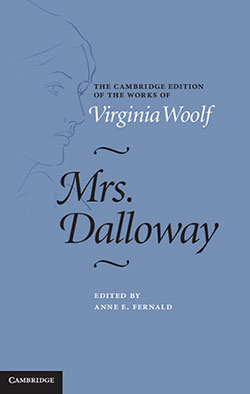 “I read everything else Woolf wrote while she was writing Mrs. Dalloway—her reading notes, diaries, letters, essays, and short fiction—and, using that, pieced together the history of how she wrote it,” said Fernald, who is the director of writing and composition at Fordham’s Lincoln Center campus.
“I read everything else Woolf wrote while she was writing Mrs. Dalloway—her reading notes, diaries, letters, essays, and short fiction—and, using that, pieced together the history of how she wrote it,” said Fernald, who is the director of writing and composition at Fordham’s Lincoln Center campus.
“For example, in the novel, Richard Dalloway thinks about the dangers of the busy London streets, especially for children, and I found that, a few weeks before Woolf wrote that paragraph her own young niece, Angelical Bell, was hit by a car.”
Fernald’s edition includes a 75-page introduction that details the novel’s composition and publication history, a general introduction, a chronology of Woolf’s life, and a separate, detailed chronology of the composition of the novel. In addition, the text includes copious explanatory footnotes (“which are as extensive as the novel itself,” Fernald said) and discussions about the differences among the editions of Mrs. Dalloway that were published during Woolf’s lifetime.
“There are more than 400 differences. Some are small differences—for instance, a semi-colon in the first American [edition]that’s a comma in the first British [edition]—and others are significant differences between earlier and later drafts of the novel,” she said.
Fernald also adds new insights that she uncovered–for instance, allusions in the novel to Homer and Shakespeare that had never before been documented but that provide important information about Woolf’s characters and plot. She gave the example of an obscure song from Shakespeare’s play Cymbeline, which the two protagonists Clarissa Dalloway and Septimus Warren Smith—who never meet—reflect on throughout the novel. The allusion, Fernald said, is meant to clue readers in to the similarities between Clarissa and Septimus, who otherwise seem to be diametrical opposites.
“It’s a beautiful, difficult, modernist text,” said Fernald, who has written previously about the importance of Mrs. Dalloway, not only because of its literary mastery but also its commentary on social issues such as the oppression of women and the neglect of veterans.
The book came out in December. Read more about Fernald’s scholarship on her blog.
]]>